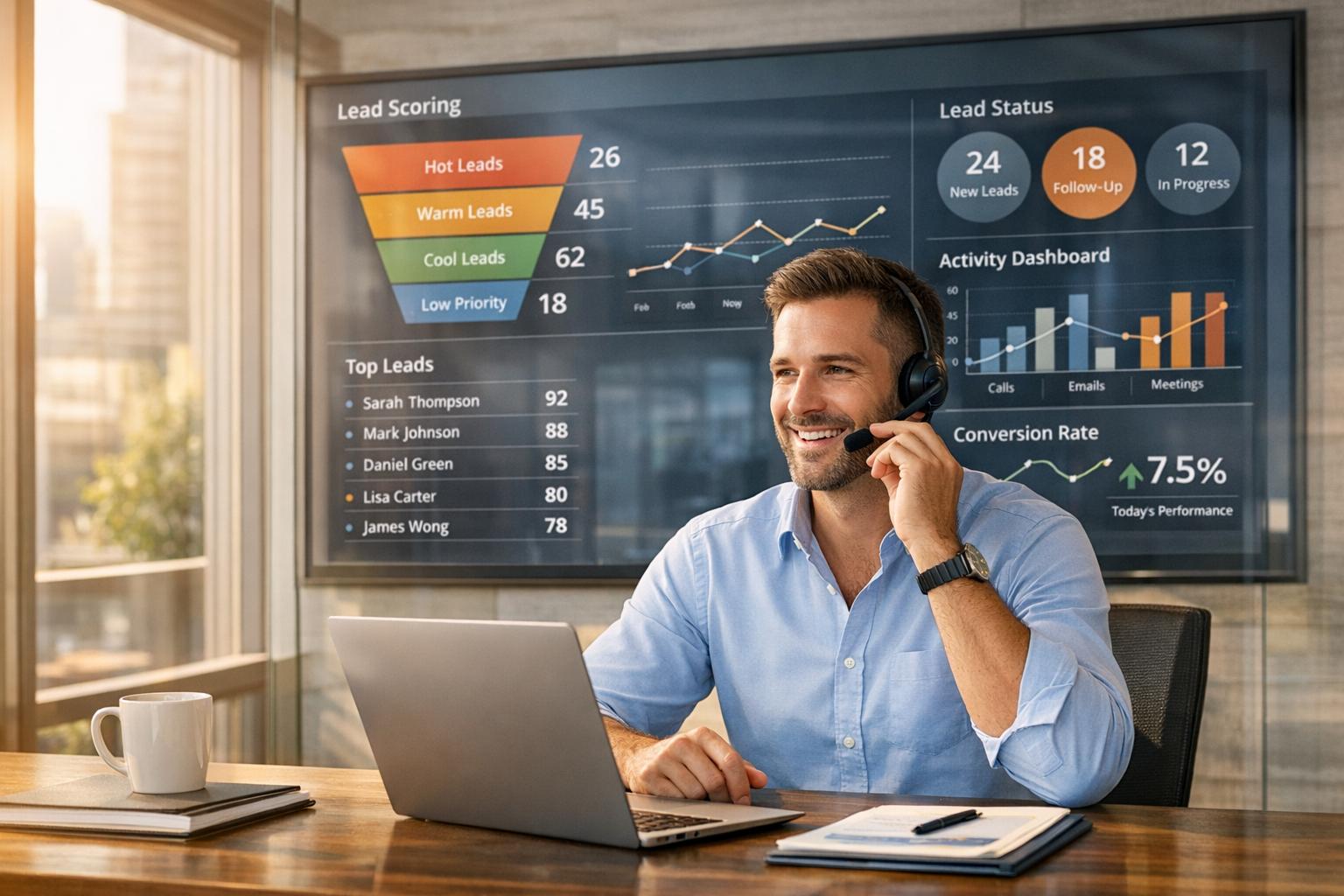
Want to scale your LinkedIn outreach without losing the personal touch? Here's how you can create effective message sequences that save time, nurture leads, and drive results.
- Why it matters: LinkedIn generates over 80% of B2B leads, yet manual outreach isn't scalable. Automated sequences, when done right, can balance efficiency with personalization.
- The key steps:
- Find and Group Your Target Audience: Define your ideal customer profile (ICP) and segment prospects based on criteria like industry, job title, or company size.
- Write Custom Message Templates: Use dynamic fields and specific details to craft personalized, concise messages that resonate.
- Build the Automated Sequence: Structure multi-step sequences with clear timing and branching logic to adapt to prospect responses.
- Monitor and Improve: Track metrics like response rates and pipeline value, then refine your approach using data insights.
- Follow Compliance Rules: Stay within LinkedIn’s messaging limits and respect user preferences to avoid account penalties.
Pro Tip: Tools like SalesMind AI can automate personalization, lead scoring, and follow-ups while ensuring compliance, helping you achieve reply rates as high as 45%.
This guide breaks down each step to help you create LinkedIn sequences that feel personal, deliver value, and drive results.
We-Connect Smart Sequence Tutorial: Automate LinkedIn Outreach Step-by-Step (2025)

Step 1: Find and Group Your Target Audience
The backbone of any effective LinkedIn messaging strategy lies in identifying and organizing your audience. A well-defined ideal customer profile (ICP) is key to grouping prospects, ensuring your outreach feels tailored and relevant. This process boils down to two main tasks: defining your ICP and segmenting your audience into targeted groups.
Define Your Ideal Customer Profile
Your ICP outlines the characteristics of your most promising prospects. To create one, focus on five essential attributes: industry, job title or function, company size, geographic location, and seniority level[2].
- Industry: Be specific. Instead of targeting a broad sector like "technology", narrow it down to niches such as SaaS, fintech, or healthcare technology. This allows you to address challenges and trends unique to that field.
- Job Titles: Zero in on decision-makers. For example, if you’re selling marketing automation tools, target roles like Marketing Director, VP of Marketing, or Chief Marketing Officer rather than casting a wide net over all "managers."
- Company Size: Different-sized companies have different needs. A startup with 20 employees won't have the same challenges as an enterprise with 5,000. Define your sweet spot using employee counts (e.g., 50–200 or 500–1,000) or revenue brackets.
- Location: For U.S.-based businesses, targeting specific states, cities like New York or San Francisco, or regions where your company operates can make your outreach more impactful.
- Seniority Levels: Focus on roles with purchasing power. Directors often influence decisions, while C-suite executives typically approve larger investments.
Here’s a quick breakdown:
| ICP Attribute | Example Values | Why It Matters |
|---|---|---|
| Industry | SaaS, Healthcare, Finance | Aligns messaging with specific challenges |
| Job Title | VP Sales, Marketing Manager | Ensures your offer resonates |
| Company Size | 50–200, 500–1,000 employees | Tailors your pitch to organizational needs |
| Location | New York, San Francisco | Personalizes outreach by region |
| Seniority | Director, C-level | Targets decision-makers with budget authority |
Once your ICP is ready, use it to group prospects into smaller, actionable segments for more personalized outreach.
Use Groups for Targeted Messaging
After defining your ICP, the next step is segmentation. Organizing your prospects into focused groups allows for smarter, more tailored messaging. In fact, B2B marketers who segment their audience report up to a 760% increase in revenue[3].
You can segment based on factors like:
- LinkedIn group membership: For example, members of digital transformation groups may respond differently than those focused on cost optimization.
- Recent job changes: Target individuals who’ve recently been promoted or started new roles.
- Company growth stage: Startups versus established enterprises often require different approaches.
- Engagement with specific content: Identify prospects interacting with topics related to your solution.
Tools like SalesMind AI simplify this process by automatically segmenting and qualifying leads, saving you time and effort[2]. This automation ensures that your outreach is both scalable and personalized.
"SalesMind AI gives us a new channel in LinkedIn sales. As a marketing agency, we will be able to use SalesMind to get in touch with precise clients on LinkedIn and create as many conversations as we can. It cuts down the working time and helps us close the deals. Best B2B sales product I have ever used."
– Si Wen, Regional Business Manager, ADI Resourcing – IT Services[1]
LinkedIn data shows that 62% of B2B marketers prioritize audience segmentation as a cornerstone of their outreach strategy[3]. Keep in mind, however, that overly broad groups can feel impersonal, while segments that are too narrow may limit your reach and become hard to manage.
Avoid common pitfalls like targeting all "managers" without considering industry relevance, failing to update your segments as your ICP evolves, or sending generic messages. Personalized subject lines alone can boost open rates by 26%, proving that tailored messaging makes a difference[3].
Step 2: Write Custom Message Templates
Now that you've segmented your audience, it's time to craft message templates that truly connect. Generic messages? They're a fast track to being ignored. In fact, personalized LinkedIn messages can boost response rates by up to 112% compared to generic outreach[6]. This makes creating tailored templates a must for successful LinkedIn sequences.
But here's the thing: personalization isn't just about adding someone's first name. Building effective templates requires balancing scalability with a genuine, human touch.
Write Dynamic and Custom Templates
Dynamic templates are a game-changer. They use variable fields to automatically fill in details specific to each prospect, making it possible to personalize at scale. The secret to success? Combine basic dynamic fields with contextual details pulled from the recipient's LinkedIn profile and activity.
Start with dynamic fields like {FirstName}, {CompanyName}, {JobTitle}, and {Industry}. Then, take it up a notch by referencing something specific - like a recent company announcement, a shared connection, or a post they've engaged with on LinkedIn.
For example, instead of saying, "Hi {FirstName}, I noticed you work at {CompanyName}", try something like:
"Hi {FirstName}, I came across your recent post about digital transformation in healthcare. Since I work with companies tackling similar challenges, I thought this might be relevant to you."
A strong message typically follows this structure: start with a personal observation or connection, introduce a brief value proposition, and end with a clear call-to-action. Keep it concise - under 100 words is ideal. LinkedIn data shows shorter messages tend to perform better. Avoid pitfalls like outdated references, over-the-top enthusiasm (looking at you, exclamation points!), or sounding overly formal. Aim for a conversational tone that feels natural in LinkedIn's professional setting.
Once you've nailed the basics, it's time to scale your efforts with the help of AI.
Use AI-Driven Personalization
AI tools can take personalization to the next level by automating the process of analyzing LinkedIn profiles and activity. For example, SalesMind AI scans profiles, recent posts, company updates, and shared connections to generate messages that feel thoughtfully crafted.
And the numbers back it up: SalesMind AI users report an average reply rate of 45% and a connection acceptance rate of 40%[1], far outpacing generic outreach results.
Here’s how it works: the AI reviews a prospect’s LinkedIn profile, recent activity, and mutual connections to identify key personalization opportunities. It then plugs those insights into your pre-designed templates, creating messages that feel specific and relevant. All of this happens automatically, saving you time while keeping the quality high.
To use AI-driven personalization effectively, start with a flexible template framework that includes placeholders for AI-generated insights. For instance:
"Hi {FirstName}, I noticed {AI_Insight_About_Company_Or_Role}. Given your experience in {Industry}, I thought you might find {Relevant_Value_Proposition} interesting."
The AI fills in these blanks with tailored details, ensuring your messages reflect genuine research and understanding.
Finally, track your results. Keep an eye on metrics like response rates, connection acceptance rates, and follow-up engagement. These insights will help you fine-tune your templates and strategies for even better outcomes over time.
Step 3: Build the Automated Message Sequence
Now that your templates are ready, it’s time to create an automated sequence that takes prospects from an initial connection to meaningful engagement. Think of this as crafting a conversational roadmap - one that feels natural and adapts to the way prospects respond. Keep in mind that personalized LinkedIn messages tend to perform better, boasting a 30% higher response rate compared to generic ones[3].
Structuring Multi-Step Sequences
A well-designed LinkedIn sequence typically follows a simple yet effective structure. Start with a thoughtful connection request, then follow up with a welcome message to express appreciation and introduce your value. After that, send one or more follow-ups that offer something useful, and finally, close with a polite message if the prospect doesn’t respond.
Here’s how it might look in practice:
- Connection Request: Make it personal. Mention something specific about the prospect, like a mutual connection, a shared group, or a recent article they wrote. This small effort goes a long way in grabbing their attention.
- Welcome Message: Once your request is accepted, send a message within 48 hours to thank them for connecting. Use this opportunity to set the tone for future interactions by briefly introducing your value proposition.
- Follow-Up Messages: These should focus on providing value. Share an insightful resource, invite them to an event, or offer industry tips. Each message should stand alone but still contribute to a bigger, cohesive conversation.
- Final Message: If there’s no response after a few attempts, send a polite closing note. This keeps the door open for future interactions without being pushy.
The key is to keep the conversation flowing naturally while ensuring every message adds value.
Timing and Branching Logic
Timing can make or break your sequence. Here’s an example timeline to guide your outreach:
- Day 0: Send the connection request.
- Day 2: Follow up with a welcome message.
- Day 5: Deliver a value-driven follow-up.
- Day 10: Send another follow-up.
- Day 17: Wrap up with a polite final message.
But timing alone isn’t enough. Adding branching logic makes your sequence smarter and more responsive. For instance, if a prospect engages - like viewing your profile or commenting on your post - pause the automated sequence and switch to a personalized response. Similarly, if someone asks to be removed from your outreach, your system should immediately stop further messages. These decision trees ensure your communication feels tailored and respectful.
Automate with SalesMind AI

Managing these sequences manually can quickly become overwhelming, which is why tools like SalesMind AI are game-changers. This platform automates follow-ups based on your timing and branching rules, turning LinkedIn outreach into a streamlined, data-driven process.
SalesMind AI brings everything together with its unified inbox, allowing you to track all LinkedIn conversations in one place. Its real-time analytics show which messages resonate most, giving you insights to refine your strategy. Plus, it handles the nitty-gritty details - like monitoring LinkedIn’s message limits, varying send times for authenticity, and pausing sequences when prospects engage.
One standout feature is its lead scoring system, which prioritizes your most promising prospects for immediate follow-up. With SalesMind AI, your outreach becomes consistent, timely, and scalable - helping you generate more leads without the manual hassle.
Next, we’ll dive into launching, monitoring, and fine-tuning your sequence for even better results.
sbb-itb-817c6a5
Step 4: Launch, Monitor, and Improve Your Sequence
Once your sequence is ready, it’s time to launch. But don’t stop there - keep an eye on the results and tweak your approach as needed. LinkedIn outreach isn’t a “set it and forget it” strategy; it’s an ongoing process that thrives on constant improvement and data-driven adjustments.
Keep an Eye on Key Metrics
The success of your LinkedIn sequence depends on the data you gather. Pay close attention to these metrics:
- Response rate: This shows how many prospects reply to your messages. While typical response rates for personalized LinkedIn messages hover around 10–15%, users of SalesMind AI report an impressive average reply rate of 45% [1].
- Acceptance rate: This measures how often your connection requests are accepted. A good acceptance rate falls between 20–30%, but SalesMind AI users achieve a higher average of 40% [1]. If your rate is low, it might be time to revisit your targeting or make your connection requests more personalized.
- Lead qualification score: Beyond just receiving replies, focus on how well the responses align with your ideal customer profile. High response rates don’t mean much if the leads aren’t the right fit.
- Pipeline value: This metric reflects the actual revenue potential generated from your outreach. For example, SalesMind AI users report an average pipeline value of $100,000 per month [1], demonstrating the kind of business impact a well-optimized LinkedIn campaign can deliver.
Start by reviewing these metrics weekly, then move to bi-weekly monitoring as your campaign matures. Early tracking helps catch issues like spam filters or poor targeting before they become bigger problems. Use the data to identify areas for improvement and guide your next steps.
Use Data to Make Improvements
Once your automated sequence is running, focus on refining it based on the insights you gather. Analyze your data to figure out which messages spark engagement, the best times to send them, and where prospects tend to drop off.
A/B testing is a great way to fine-tune your strategy. Experiment with different subject lines, message lengths, and calls-to-action. For instance, if you notice that referencing a prospect’s recent LinkedIn activity increases response rates by 20%, update your templates to include more of these personal touches. One B2B SaaS company found that sending messages on Tuesdays and Thursdays boosted their reply rates by 20% and increased qualified leads by 35% [1].
If follow-ups aren’t performing well, try making them shorter and more focused on delivering value. Sometimes, a simple message referencing shared interests or recent company news can reignite a prospect’s interest.
SalesMind AI can take your optimization efforts to the next level with its AI-powered lead scoring and analytics dashboard. These tools help you identify your most promising prospects and uncover trends in your outreach. The platform even pulls insights directly from prospect profiles, enabling you to craft hyper-personalized messages that resonate deeply.
"SalesMind AI has elevated my LinkedIn experience, offering exceptional customer service to maximize the impact of their product. Their team not only assisted with implementation but also provided insights to fine-tune my campaigns, enhance my profile's appeal, and boost lead acquisition. The tangible results in terms of high-quality leads and business growth speak volumes. SalesMind AI is not just a tool but a dedicated partner in achieving success on LinkedIn." - Bennett Newhook, Founder, Outport [1]
Armed with these insights, you're ready to ensure your outreach stays aligned with LinkedIn’s policies in the next step.
Step 5: Follow Compliance and Best Practices
Creating effective LinkedIn message sequences isn’t just about crafting engaging content - it’s also about staying within LinkedIn’s rules. The platform has strict policies to prevent spam and maintain a professional atmosphere. Breaking these rules can lead to account restrictions or even permanent bans. By following best practices, you can ensure your outreach remains effective while safeguarding your professional reputation.
Stick to LinkedIn's Rules
LinkedIn has clear limits on how many connection requests and messages you can send. These rules are in place to keep the platform free from spam and maintain its integrity. Staying within these boundaries is key to keeping your account in good standing.
Don’t exceed messaging limits. LinkedIn recommends sending no more than 100 connection requests per week. Going over this limit could result in warnings or even temporary account bans. Their algorithm keeps a close eye on unusual activity, especially if recipients report your messages as spam. Sending too many requests or messages in a short time can flag your account for review.
Respect preferences and track your account health. If someone isn’t responding or opts out of your outreach, stop messaging them. Over 70% of LinkedIn users ignore or delete messages that feel automated or irrelevant[5]. Pay attention to metrics like response rates and opt-outs. If you notice fewer people accepting your requests or get notified about your activity, adjust your approach quickly to avoid penalties. Regularly monitoring your account helps you address issues before they become serious.
By following these guidelines, you’ll be set up to execute outreach strategies that not only comply with LinkedIn’s rules but also deliver results.
Tools like SalesMind AI can help you stay compliant. It integrates directly with LinkedIn to ensure you respect messaging limits and recipient preferences. Plus, its AI-powered system tracks critical metrics, keeping your outreach effective and within safe boundaries.
Master Outreach Best Practices
Compliance is essential, but it’s just the foundation. To truly stand out, you need to use smart outreach techniques. The difference between successful LinkedIn campaigns and being flagged as spam often comes down to following proven strategies. Here’s a quick comparison of what works versus common mistakes:
| Best Practice | What It Means | Common Mistake | What Goes Wrong |
|---|---|---|---|
| Personalization | Reference specific posts, events, or roles | Generic Templates | Sending mass, non-specific messages |
| Concise Messaging | Keep it short and relevant | Long-Winded Messages | Rambling or including irrelevant details |
| Respect Preferences | Honor opt-outs and avoid repeated outreach | Ignoring Feedback | Repeatedly messaging unresponsive contacts |
| Compliance Monitoring | Stay within limits and adjust campaigns as needed | Neglecting Limits | Exceeding daily or weekly message caps |
Make it personal. Personalized messages have a 30-50% higher response rate compared to generic ones[4]. Instead of using a one-size-fits-all approach, mention something specific about each prospect. This could be a recent post they shared, a company milestone, or even a mutual connection. Showing that you’ve taken the time to learn about them makes your outreach feel genuine.
Keep it short and to the point. Your prospects are busy and likely receive dozens of messages daily. Don’t waste their time with long introductions or detailed product pitches. Instead, clearly explain how you can provide value in just a few sentences.
Focus on building relationships. The best LinkedIn outreach isn’t about making an immediate sale - it’s about forming real professional connections. Share useful insights, congratulate them on achievements, or offer helpful resources without expecting anything in return. This approach helps establish trust and opens the door for future opportunities.
These strategies align with the earlier steps in creating personalized, effective outreach. SalesMind AI makes it easier to follow these best practices by automating personalized messaging at scale. Its AI analyzes prospect profiles to help you craft messages that are relevant, engaging, and unlikely to be flagged as spam. This way, you can focus on building meaningful connections while staying compliant with LinkedIn’s rules.
Conclusion
Crafting effective LinkedIn message sequences requires a blend of precise targeting and smart automation. The five steps detailed in this guide work together to form a streamlined outreach strategy that delivers measurable results.
Begin by grouping your audience strategically to ensure your messages reach the right people. Defining clear customer profiles and segmenting prospects builds a strong foundation for success. With personalized templates, response rates can soar by as much as 50%, setting the stage for smooth automation and continual improvements.
Automation tools allow for multi-step sequences that feel personal, using well-timed messages and branching logic to ensure no prospect slips through the cracks. Performance tracking is equally important, helping you identify what’s working and refine your approach as you go. And, of course, following compliance guidelines safeguards your reputation and keeps your account secure.
The results speak for themselves. For instance, Si Wen, Regional Business Manager at ADI Resourcing - IT Services, shared their experience:
"SalesMind AI gives us a new channel in LinkedIn sales. As a marketing agency, we will be able to use SalesMind to get in touch with precise clients on LinkedIn and create as many conversations as we can. It cuts down the working time and helps us close the deals. Best B2B sales product I have ever used." [1]
FAQs
What steps can I take to ensure my LinkedIn message sequences follow LinkedIn’s rules and avoid penalties?
To ensure your LinkedIn message sequences stay within the platform's rules and avoid potential penalties, it's important to prioritize genuine communication and follow LinkedIn's guidelines. Steer clear of spamming by limiting the number of messages you send in a short timeframe, and make sure each message is tailored and meaningful to your audience.
It's equally important to avoid using language that's overly promotional or could be considered misleading. Always respect the preferences of the people you're reaching out to - if someone asks you to stop messaging, honor that request immediately. Tools like SalesMind AI can assist in automating your outreach efforts while keeping your messages personalized, professional, and aligned with LinkedIn's standards.
How can I personalize LinkedIn messages while maintaining efficiency and scale?
To make your LinkedIn messages feel personal without sacrificing efficiency, consider using tools like SalesMind AI. This platform takes care of essential tasks such as crafting tailored messages, qualifying leads, and managing follow-ups, enabling you to connect with a larger audience effectively.
With an AI-driven unified inbox, advanced lead scoring, and smooth LinkedIn integration, SalesMind AI simplifies your outreach process. It ensures you can maintain meaningful interactions while saving time and achieving better outcomes.
How can AI tools like SalesMind AI improve LinkedIn outreach campaigns?
AI tools like SalesMind AI simplify LinkedIn outreach by automating tasks like sending personalized messages, qualifying leads, and managing follow-ups. This means businesses can save time while still keeping interactions meaningful and engaging.
With an AI-powered unified inbox, advanced lead scoring, and smooth LinkedIn integration, SalesMind AI helps streamline the sales process. It enables you to connect with the right prospects more efficiently and at scale. By taking care of repetitive tasks, it frees you up to concentrate on what matters most - building relationships and closing deals.


.avif)


